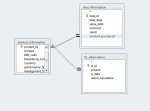Firstly apologies as I'm a novice at Access and am still familiarising myself so I appreciate any help you can provide.
I'm trying to create a query that will return a calculated field called "PnL".
The formula for "PnL" is as follows: PnL = notional*management_fee*NAV*
The "notional" field is a value derived from a table called "Deal_information" (primary key deal_id) and has an associated "management_fee" and "product" field. So obviously finding the product of the notional field and the management_fee field isn't a problem.
However "NAV" field is from another table (VL_information) that contains the historical Net Asset Value of each product. Fields are (VL_id, vl_date, product, NAV).
Therefore for each "notional" record I would like to return the historical PnL.
By way of example. Lets say that the notional valuefor a particular record is $100, with a corresponding management fee of 10% (the managment fee is product dependent). Then I would like to find the evolution of PnL by multiplying this record by the evolution of the NAV. This would do so for each notional value.
Can anyone help me in how to achieve this? I have attached a snapshot of the table relationships for reference.
Many thanks,
MOR
I'm trying to create a query that will return a calculated field called "PnL".
The formula for "PnL" is as follows: PnL = notional*management_fee*NAV*
The "notional" field is a value derived from a table called "Deal_information" (primary key deal_id) and has an associated "management_fee" and "product" field. So obviously finding the product of the notional field and the management_fee field isn't a problem.
However "NAV" field is from another table (VL_information) that contains the historical Net Asset Value of each product. Fields are (VL_id, vl_date, product, NAV).
Therefore for each "notional" record I would like to return the historical PnL.
By way of example. Lets say that the notional valuefor a particular record is $100, with a corresponding management fee of 10% (the managment fee is product dependent). Then I would like to find the evolution of PnL by multiplying this record by the evolution of the NAV. This would do so for each notional value.
Can anyone help me in how to achieve this? I have attached a snapshot of the table relationships for reference.
Many thanks,
MOR

